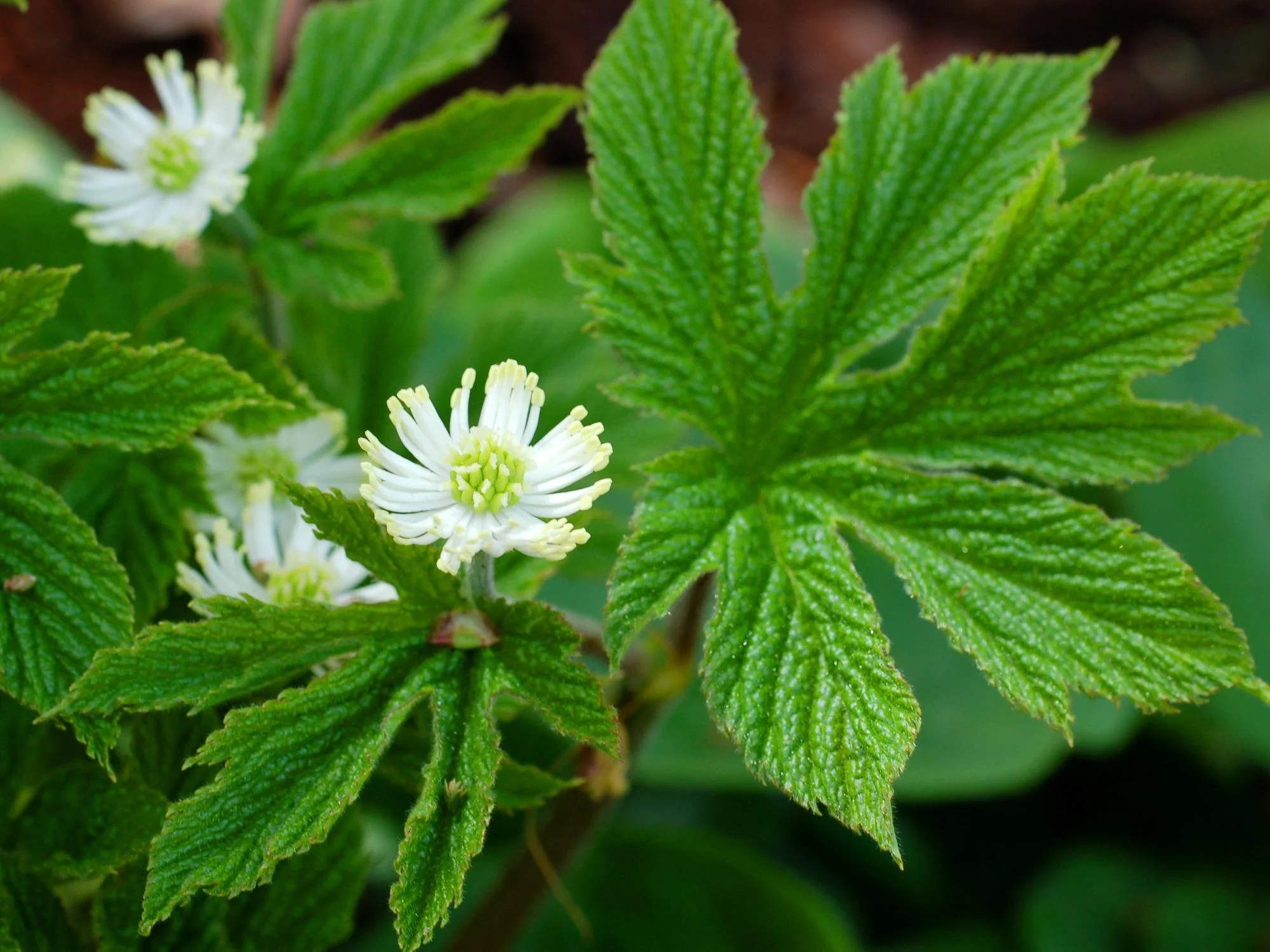Goldenseal (Hydrastis canadensis)
Medicinal Profile of
Goldenseal (Hydrastis canadensis)
Goldenseal (Hydrastis canadensis) is a woodland perennial native to North America, long used by Indigenous peoples and later adopted by Eclectic physicians for its powerful antimicrobial and mucous membrane–toning actions. Known as a “king of tonics” in the 19th century, it is valued for acute infections of the digestive, respiratory, and urinary systems. Its primary alkaloid, berberine, is strongly antimicrobial and bitter, making goldenseal a potent short-term remedy but unsuitable for daily or nutritive use. Modern conservation concerns highlight the need to source only cultivated root, as wild populations are endangered.
-
👉 Tastes describe the initial impression a herb leaves on the tongue, and they reveal its deeper actions in the body, shaping digestion, circulation, and tissue response.
Bitter – Stimulates digestion, dries excess fluids, clears irritation and toxins.
Astringent – Tones and tightens tissues and provides firmness to lax or weakened tissues, helping restore barrier integrity and resilience.
-
👉 Qualities describe the felt nature of a substance or practice, and how it acts in the body beyond nutrients or chemistry.
Drying – Reduces dampness, excessive secretions, or boggy tissue.
Stabilizing – Clears inflammation, irritation, and infection.
Light at first – The bitter and astringent taste initially clears heat, mucus, and congestion, giving a sense of sharpness and lift.
Depleting if overused – The dense alkaloid and tannin content can contract tissues and feel draining on vitality with prolonged or excessive use, not in a nutritive sense, but in the energetic cost of strong bitter and contracting actions.
Penetrating – Strongly targets mucous membranes and infection sites.
-
Decoction of dried root – Strong bitter tea, used internally for acute digestive or respiratory infection.
Powder/capsules – Common, but often overused; best reserved for short-term therapeutic use.
Topical wash/ointment – Applied to infected wounds, sores, or rashes.
Glycerite Extract (1:5) – Alcohol-free option for concentrated use in acute infections or mucous membrane inflammation; safer for children and those avoiding alcohol.
Indicated Patterns by Affinity
👉 Indicated patterns describe the functional state of the body and its organs and/or tissues, showing whether they are dry, atrophied, too damp (pressure), stagnant, lax, inflammed, sluggish, tense or underactive. The Primary Indicated Pattern is the main state where this remedy works best. Secondary Indicated Pattern(s) are the patterns that often develop over time when the primary state is left unaddressed. The primary pattern must be supported first, as this allows the secondary patterns to naturally ease or resolve.
👉Affinities are the organ systems and tissues where the remedy acts most strongly.
-
Congestive (Primary Indicated Pattern) – When fluids, wastes, or circulation become stagnant, leading to heaviness, fullness, swelling, or bogginess.
Examples: Sluggish digestion with a heavy, coated tongue, Gas and bloating from fermentation, Thick, sticky mucus in the gut.Irritative (Secondary Indicated Pattern) – When tissues are overstimulated or inflamed, becoming reactive and sensitive.
Examples: Gut burning from microbial imbalance, Loose stools with irritation, Sour stomach with inflammation. -
Congestive (Primary Indicated Pattern) – When bile or metabolic wastes stagnate, creating pressure or sluggish detoxification.
Examples: Fullness under the right ribcage, Constipation with pale, sticky stools, Yellowish complexion from bile congestion. -
Inflammatory (Primary Indicated Pattern) – When the immune system reacts strongly, creating irritation, redness, or pain.
Examples: Red, inflamed mucous membranes, Sore throat with heat and swelling, Fever from acute infection.Auto-Inflammatory (Secondary Indicated Pattern) – When the immune system attacks excessively, creating cycles of self-driven inflammation.
Examples: Cyclical tissue irritation, Recurrent flare-ups of mucosal inflammation, Chronic swelling without clear triggers. -
Congestive (Primary Indicated Pattern) – When mucus builds up, slowing or obstructing normal function.
Examples: Boggy sinus congestion, Thick yellow-green mucus in the nose or throat, Coated or sticky feeling in the mouth.Irritative (Secondary Indicated Pattern) – When membranes become inflamed, reactive, or overly sensitive.
Examples: Burning in nasal passages, Red, inflamed throat, Tender, irritated gums.
-
👉 Medicinal actions describe the specific ways a food influences organ systems and body functions.
Digestive System
Bitter tonic – Stimulates bile and digestive secretions.
Antimicrobial – Treats gut infections, diarrhea.
Astringent – Reduces excessive secretions in mucous membranes.
Respiratory System
Decongestant – Clears thick catarrh from sinuses and lungs.
Antimicrobial – Targets respiratory infections with damp, boggy mucus.
Urinary System
Antimicrobial – Helps clear infection in urinary tract.
Astringent – Tones mucous membranes, reducing excessive discharge.
Integumentary System (Topical)
Antimicrobial – Applied as a wash for infected wounds, ulcers, eczema.
Anti-inflammatory – Reduces redness, irritation, and inflammation in skin infections.
-
👉 Constituents are the natural compounds in a food that give rise to its actions in the body.
Isoquinoline alkaloids (berberine, hydrastine, canadine) – Strong antimicrobial, bitter, astringent.
Tannins – Tissue-toning, antimicrobial.
Volatile oils, resins – Protective and antimicrobial.
-
Third Degree – Strong systemic effects; potent antimicrobial and mucous membrane–toning actions. Should be used with care and not long term.
-
Antibiotics – May have additive effects; caution in concurrent use.
Anticoagulants – May increase bleeding risk.
Cytochrome P450 drugs – Berberine may affect drug metabolism.
-
Endangered species – Use only cultivated sources.
Not for long-term use – Can dry and weaken digestion with chronic dosing.
Pregnancy – Contraindicated; uterine stimulant.
Children – Use only in small, appropriate acute doses.
Hypofunction pattern – Avoid; goldenseal worsens depletion and coldness.
-
Traditional Sources
King’s American Dispensatory (1898). Eclectic physicians valued goldenseal for mucous membrane conditions.
North American indigenous traditions – Used as a wash for wounds, infections, and eye conditions.
Modern Sources
Brown, P. N., & Roman, M. C. (2008). “Determination of hydrastine and berberine in goldenseal by HPLC.” Journal of AOAC International, 91(3), 694–701.
Abascal, K., & Yarnell, E. (2004). “Goldenseal: Traditional uses, current clinical research, and regulatory issues.” Alternative & Complementary Therapies, 10(5), 249–254.
USDA Plant Database – Hydrastis canadensis profile.



